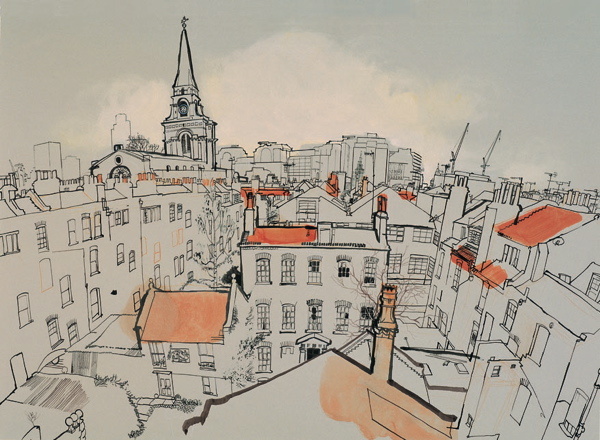Miloš Kosec, a PhD candidate in Arts and Humanities at Birkbeck reflected on the symposium that looked into the ever-changing Spitalfields. The symposium was organized by Dr. Lesley McFadyen (HCA) and Dr. Joel McKim (FMACS) and funded by the Architecture Space and Society Centre and the Birkbeck Institute for the Humanities.
(The image is used with the courtesy of Lucinda Rogers: “View over Spitalfields looking west”; 2002 Ink, crayon and watercolour on board 60 x 84cm)
A neighbourhood of continuance and ruptures, of social prestige and dereliction: Spitalfields seems to embody the extreme transition of urban fabric thorough Modernity. In the last decades it has been redefined yet again because of its ever-diminishing distance to the “Wall of Money”, the shadowing towers of The City. Its character today may seem as a result of a long-running historical roller-coaster; the ever-changing dynamics ranges from 17th century economic prosperity to 19th century slumification and through 1970s counter-culture activism to contemporary gentrification. What appears as necessary development to some signifies insensitive destruction to others. Development and destruction tend to be intrinsically linked.
The symposium “Spitalfields: On Development and Destruction” at Birkbeck School of Arts on Friday 18th November served as a platform for a wide spectrum of different voices, covering the past, the present and various visions of future development of this East London historic area. The first panel’s speakers were Miles Glendinning (Director of the Scottish Centre for Conservation Studies, Edinburgh College of Arts), who talked about historical changes in the social and political perspectives on conservation, and Peter Guillery (Editor of the Survey of London, The Bartlett) who demonstrated the importance of new approaches in mapping and recording of not only architectural but also oral and social histories in the latest Survey of London project, focusing on Whitechapel. The speakers of the second panel were representatives of civil initiatives and community institutions in Spitalfields with Oliver Leigh Wood representing The Spitalfields Trust active since the seventies and Lucinda Rogers from the organisation Reclaim London. Final panel’s speakers were archaeologist Chris Thomas (Director of Heritage Consultancy, Museum of London Archaeology) who drew the attention to rich Roman and medieval layers of Spitalfields that were somewhat paradoxically uncovered and preserved only because of the destruction of the historic Spitalfields Market. Thomas’s discussion of techniques of preservation and architectural integration of archaeological remains bridged the centuries separating his from final speaker’s profession: architect Rab Bennetts (Bennetts Associates Architecture Studio), an architect involved in the design process ofthe building being built on the site of the Fruit and Wool Exchange. Bennetts’s talk effectively exposed the various conflicting dilemmas and forces that are at play in the contested territory of community life, architectural heritage and entrepreneurial profit.
Each of the speakers not only presented a specific perspective on the area but also introduced a specific vocabulary. Various terminologies made discussions lively, but they also shed a light on a structural difficulty for the parties involved in redevelopment and conservation in understanding each other. Terminology represents the first battlefield. This is where discussion proved invaluable, as it provided the means to understand the starting assumptions of different actors. It also suggested that fashion and ever-changing market value play a crucial role in preservation strategies. While only Georgian architecture was considered of prime importance in Spitalfields decades ago, Victorian architecture has lately been acknowledged as well. Subsequent architectural production, however, often still falls out of consideration. Rather than an objective or autonomous field, conservation seems to be caught between predominant cultural patterns and market forces. In this light the role of the architect proved especially difficult as well as multi-faceted; a role where conflicts tend to concentrate as the architect is professionally bound to the (predominantly entrepreneurial) client on one hand and has a (nowadays mostly voluntary) social and historical responsibility on the other. The final discussion articulated the decisive architectural dilemma: is a negotiated compromise between the two opposites really the most desirable solution, especially in an area as sensitive as Spitalfields? And if not, which actor should be given a say over others?




Leave a Reply